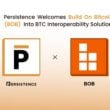Note: Persistence has pivoted to liquid staking and building DeFi primitives to increase the utility for staked assets. This article is only for archive purposes.
(Visit here to read our latest blogs)
In the previous blog post, we introduced Persistence and talked about our focus on ‘real-world’ adoption. In this blog post, we introduce Asset-Based Lending and Persistence’s focus on the Trade Finance use case
The lending system was originated in Ancient Greece and Rome 3000 years ago. Bills of exchange for sea-borne trade originated in India in 321 BC. However, apart from recent efforts at digitization and development of alternative forms of lending such as P2P lending, there haven’t been too many innovations as far as matching of lenders and borrowers goes.
What is Asset-Based Lending?
Asset-Based Lending refers to a loan that is secured using an asset or multiple assets of the borrower as collateral. Assets that may be used as collateral to borrow against are invoices, accounts receivable, inventory, marketable securities, property, etc.
Persistence’s initial focus is Invoice financing — using a seller’s accounts/trade receivables as collateral to obtain financing against.
Trade & Trade Financing use case on Persistence:
The Global Trade Industry is a $19.6 Trillion Industry with more than 80% of trades requiring some sort of financing.
The most important problems that need to be solved in the Trade and Trade financing Industry are:
- Asynchronous communication channels: Most of the documents in this industry today are shared via informal communication channels like Whatsapp, WeChat, etc, which leaves no audit trail.
- Long settlement times: Settlement via SWIFT takes place on a T+2/3 basis. Every additional day it takes for transactions to be settled is an opportunity cost for traders in terms of additional trades that could have been performed. According to a BCG report commissioned by DTCC, the annual cost of this inefficiency is more than $10 Billion.
- Difficulties in obtaining financing: The Capital adequacy requirements imposed on financial institutions post the global financial crisis has made it increasingly difficult for SMEs and MSMEs to obtain financing for their business needs. The overall global trade and business financing gap stands at $1.5 Trillion with 45% of this gap being in Asia.
What is Comdex?
Comdex is a physical commodities trading and trade financing solution built from the ground-up using the Persistence SDK. The Comdex Platform covers the end-to-end journey of traders all the way from trader onboarding to trade financing. The key steps of the trade flow are as follows:
- Trader onboarding
- Asset Exchange
- Trade Settlement
- Trade Financing
In its initial stages, Comdex was primarily focused on the deployment of the ‘Trade Workflow’ service offering which allows the counter-parties involved in a trade to securely exchange documentation pertaining to a commodity consignment, digitally create and sign legally binding contracts, and also to conduct real-time negotiations.
How does the Comdex Platform work?
Comdex uses Persistence SDK modules such as trader on-boarding, asset tokenization, trade financing and many more to offer a complete trade and trade financing solution for traders on the Comdex platform.
The Comdex flow:
- Buyers and Sellers are matched on the Comdex platform and an invoice (trade receivable) is generated which is then tokenized.
- The seller then requests for financing against this trade receivable.
- The Primary financier assesses risk and provides financing against the tokenized trade receivable which is used as collateral.
Comdex offers an end-to-end solution for traders while also digitizing an Industry that has seen very little technological advancements in the previous decades.





